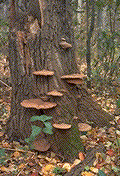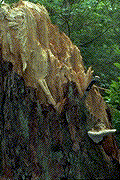Archived Content
Information identified as archived on the Web is for reference, research or recordkeeping purposes. It has not been altered or updated after the date of archiving. Web pages that are archived on the Web are not subject to the Government of Canada Web Standards. As per the Communications Policy of the Government of Canada, you can request alternate formats on the Contact Us page.
White Mottled Rot
Ganoderma applanatum (Pers.) Pat.
(= Fomes applanatus (Pers.) Gill.)
(= Polyporus applanatus (Pers.) Wallr.
Basidiomycotina, Aphyllophorales, Polyporaceae
Hosts:Ganoderma applanatum is commonly recorded on deciduous trees, but is also found on a wide range of coniferous tree species. In B.C. it has been reported on maple, alder, birch, beech, apple, poplar, cherry, plum, oak, willow, elm, amabilis and grand fir, white and Sitka spruce, Scots pine, Douglas-fir, mountain and western hemlock, and western redcedar. In other parts of North America, it is found on western white pine, subalpine fir, Engelmann spruce, and many other deciduous hosts (see Farr et al., 1989).
Distribution: This fungus affects trees in all regions of the province.
Identification: The fruiting bodies are perennial, leathery to woody and tend to be flat or plate-like (Fig. 13a). The upper surface is light brown, deeply zoned, and often covered with a dusting of brown spores. The margin, when fresh, is usually white. The context is reddish-brown but may contain a light grey zone. The lower surface is white turning brown in old specimens or when bruised or marked, hence the common names "picture fungus" or "artist's conk."
In the early stage of the decay, the affected wood of most species becomes bleached and is encircled by a dark brown stain. In western hemlock this stage is violet to lilac in colour. In the advanced stage, the wood becomes white, mottled, and spongy (Fig. 13b). Black zone lines may or may not be present.
Microscopic Characteristics: Hyphae in the context of the fruiting body thin-walled with clamp connections, skeletal hyphae thick-walled, brown. Basidiospores ovoid, truncate at the distal end, with two walls, connected by inter-wall pillars, brown, IKI-, (8)9-12 x 8-10 µm. Growth in culture moderately-rapid, mat white, or becoming buff, clamp connections, laccase positive. Stalpers: 1 3 (7) (8) (11) (12) (13) 14 17 18 21 24 25 30 (31) (33) (35) 37 (38) 39 42 44 45 47 (48) (50) 51 52 53 (57) (61) 63 (80) (82) 83 89 (90) (94).
Damage:Ganoderma applanatum is an important decay of dead trees but may enter living trees through wounds and cause extensive damage. In hemlock, decay is considered to extend 3 m above and below a sporophore.
Remarks: A related species, Ganoderma oregonense (Pers.) Pat, also causes a root and butt rot of living and dead trees in western North America, particularly on true firs and western hemlock. Sporophores of this fungus are often very large (up to 80 cm across), and have a shiny reddish upper surface. Unlike G. applanatum, the pore surface does not darken when bruised.
References:
Gilbertson, R. L. and L. Ryvarden. 1986. North American Polypores. 1: 291. Fungiflora, Oslo.
Figures
Click on any image to see the full size version.
Press "Back" on your browser to return to this screen.

Figure 13a: Fruiting bodies on Populus spp. Note the brown spores on the tree bark and upper surface of some of the fruiting bodies.
 Figure 13b: Advanced decay caused by G. applanatum.
Figure 13b: Advanced decay caused by G. applanatum.
 This Web page has been archived on the Web.
This Web page has been archived on the Web.